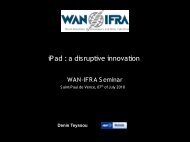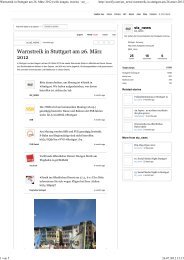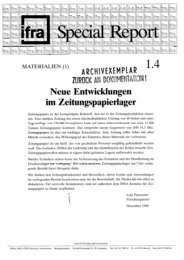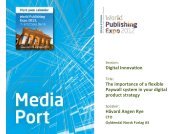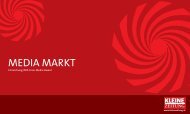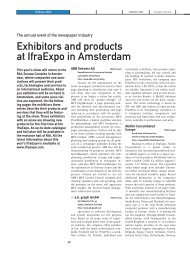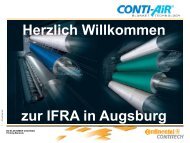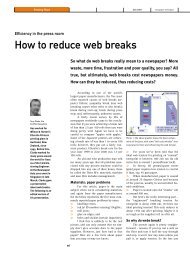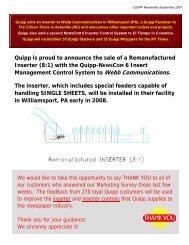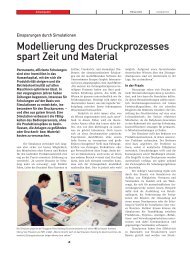Create successful ePaper yourself
Turn your PDF publications into a flip-book with our unique Google optimized e-Paper software.
Ferroelectric Printing Surface<br />
MAN Roland / pm<br />
Special ferroelectric<br />
ceramics<br />
surface<br />
Negative<br />
Charge<br />
beam<br />
+<br />
Imaging process:<br />
Changing the orientation of dipole domains<br />
in a ferroelectric ceramic surface by charging.<br />
3.000 dpi, 2m/s, Liquid toner.<br />
Either usage as master (30.000 and more copies) or as masterless (copy “1”)<br />
process. Introduced 1995, not available, perhaps at DRUPA 2004<br />
31<br />
© Hübler 2000<br />
Institute for Print and Media Technology of Chemnitz Technical University, Germany
Creo‘s Spray-on Process & Agfa‘s LiteSpeed fluid<br />
Spraying a<br />
Photosensitive<br />
coating<br />
Laser<br />
beam<br />
+<br />
Imaging process:<br />
Spraying a photo or thermosensitive<br />
(LiteSpeed) coating onto<br />
the cylinder. Exposing this film layer<br />
with Creo’s laser imaging<br />
technology, developing it<br />
afterwards.<br />
For the next job, you have to remove<br />
the imaging layer and to start a new<br />
coating.<br />
Offset printing.<br />
32<br />
© Hübler 2000<br />
Institute for Print and Media Technology of Chemnitz Technical University, Germany
Goss‘ ADOPT CP<br />
Special Ni surface<br />
of cylinder<br />
Laser<br />
beam<br />
+<br />
Imaging process:<br />
Laser induced excitation of a<br />
Nickel surface in a copper solvent.<br />
Chemical processing and a total new<br />
press engineering necessary.<br />
133 lpi<br />
Special Cu + solvent<br />
Special single fluid wet offset<br />
printing.<br />
Gapless cylinders.<br />
Introduced 1997,<br />
No information on further<br />
developments since that time<br />
33<br />
© Hübler 2000<br />
Institute for Print and Media Technology of Chemnitz Technical University, Germany
Inkjet Imaging at pm Institute<br />
Inkjet<br />
Imaging<br />
Head<br />
+<br />
Imaging process:<br />
Imaging the surface of the printing<br />
cylinder with a phase-change inkjet,<br />
providing the oleophilic structure.<br />
Offset printing.<br />
Introduced 1998<br />
34<br />
© Hübler 2000<br />
Institute for Print and Media Technology of Chemnitz Technical University, Germany
Inkjet Imaging Approach of pm Institute<br />
Process steps:<br />
Printing<br />
cylinder<br />
1. Inkjet Imaging<br />
Inkjet<br />
Imaging<br />
Head<br />
+<br />
35<br />
© Hübler 2000<br />
Institute for Print and Media Technology of Chemnitz Technical University, Germany
Inkjet Imaging Approach of pm Institute<br />
Process steps:<br />
Printing<br />
cylinder<br />
+<br />
+<br />
+<br />
Fountain<br />
solution<br />
1. Inkjet Imaging<br />
2. Offset Printing<br />
Inkjet<br />
Imaging<br />
Head<br />
+<br />
+<br />
+<br />
+<br />
Offset<br />
inking unit<br />
+<br />
Blanket<br />
cylinder<br />
paper<br />
+<br />
36<br />
© Hübler 2000<br />
Institute for Print and Media Technology of Chemnitz Technical University, Germany
Inkjet Imaging Approach of pm Institute<br />
Printing<br />
cylinder<br />
Erasing unit<br />
+<br />
+<br />
+<br />
Fountain<br />
solution<br />
Process steps:<br />
1. Inkjet Imaging<br />
2. Offset Printing<br />
Inkjet<br />
Imaging<br />
Head<br />
+<br />
+<br />
+<br />
+<br />
Offset<br />
inking unit<br />
3. Erasing<br />
+<br />
Blanket<br />
cylinder<br />
paper<br />
+<br />
37<br />
© Hübler 2000<br />
Institute for Print and Media Technology of Chemnitz Technical University, Germany
Inkjet Imaging Approach of pm Institute<br />
38<br />
© Hübler 2000<br />
Inkjet<br />
Imaging<br />
Head<br />
Printing<br />
cylinder<br />
paper<br />
Erasing unit<br />
+<br />
+<br />
+<br />
+<br />
+<br />
+<br />
+<br />
+<br />
Fountain<br />
solution<br />
Offset<br />
inking unit<br />
Blanket<br />
cylinder<br />
Process steps:<br />
1. Inkjet Imaging<br />
2. Offset Printing<br />
3. Erasing<br />
1. Inkjet Imaging<br />
next job<br />
Institute for Print and Media Technology of Chemnitz Technical University, Germany<br />
+<br />
Inkjet much cheaper<br />
than laser:<br />
• high imaging speed<br />
• reduced investment<br />
but lower resolution<br />
• 900 dpi
Results of Inkjet Ct-Cylinder<br />
Offset printed<br />
dots on paper<br />
Imaged dot on<br />
cylinder surface<br />
39<br />
© Hübler 2000<br />
Institute for Print and Media Technology of Chemnitz Technical University, Germany
The technical problems<br />
Imaging itself is no problem but a well known technology.<br />
The main problem is the function layer on cylinder:<br />
1. It has to be very uniform to exclude image errors<br />
2. It has to be durable in the offset printing process for<br />
higher run length<br />
3. It has to be totally erasable (within a molecular scale!)<br />
for many job changes to avoid ghost image from the<br />
job which has run before.<br />
40<br />
© Hübler 2000<br />
Institute for Print and Media Technology of Chemnitz Technical University, Germany
Demands to Ct-Press Technologies in the newspaper<br />
• Press concepts adapted to the newspaper production :<br />
1. New stand-alone press<br />
2. Additional imprint unit to be combined with traditional<br />
(perhaps already installed) offset units<br />
• Real cost (material) and time saving<br />
Total make ready time<br />
(erasing, imaging, etc.)<br />
Quality<br />
Investment<br />
Reduced needs in spacing<br />
max. 5 min (better < 3 min)<br />
min. 600 dpi S/W (better 1.200 dpi)<br />
below 400.000 Euro<br />
Flexible position of the imprint unit along the web width<br />
41<br />
© Hübler 2000<br />
Institute for Print and Media Technology of Chemnitz Technical University, Germany
Summary<br />
1. Internal Ct-Plate is not interesting for digital imprint<br />
applications because of the long changing times (~ 15 min)<br />
and the plate material costs. It is an intermediate state.<br />
2. Ct-PRESS is on the way, but today there is no proofed solution.<br />
3. Now, MAN’s DICOweb has to show it’s advantages in praxis. It is a<br />
very future oriented concept, but surely not the last version of<br />
CtPRESS.<br />
4. The DICOweb today is not a upgrade kit for adding an imprint unit to<br />
existing presses but a totally new investment.<br />
Technically, at DRUPA 2004 more usable technologies for<br />
newspapers could be available, if the manufactures decide<br />
early to work on it. We have to push their R&D activities!<br />
42<br />
© Hübler 2000<br />
Institute for Print and Media Technology of Chemnitz Technical University, Germany
Ct-PRINT (DDP Direct Digital Print)<br />
Toner based processes<br />
• Electrostatic printing (Laser printer):<br />
Heidelberg/Danka, IBM, Indigo, NexPress, Océ, Xeikon, Xerox<br />
+ various office solutions (cluster printing )<br />
• Magnetographic printing: Xeikon/Nipson<br />
• Electron beam (Ionography): Xerox/Delphax<br />
2<br />
Inkjet based printing<br />
• Scitex printheads: Scitex Versamark<br />
• Xaar Printheads: Barco<br />
Specialities<br />
• Elcography: Elcorsy<br />
B/W or 4 colour: Multiplication of the single colour printing unit with<br />
various design solutions (collection cylinder or belt, …)<br />
Adjustments in toner/ink are necessary, but today mostly solved.<br />
43<br />
© Hübler 2000<br />
Institute for Print and Media Technology of Chemnitz Technical University, Germany
Heidelberg-Eastman Kodak:<br />
NexPress 2100<br />
• Electrostatic printing<br />
• 600dpi, multibit<br />
• 2100 prints/h<br />
• Paper 80-300 g/m 2<br />
• LED imaging<br />
• Rubber transfer cylinder<br />
• Solid toner („DryInk“)<br />
• 4-colour<br />
44<br />
© Hübler 2000<br />
Institute for Print and Media Technology of Chemnitz Technical University, Germany
IBM: InfoPrint 4000<br />
• Electrostatic printing<br />
• 480/600dpi<br />
• 436 print/min (A3)<br />
• Laser imaging<br />
• Powder toner<br />
• 1-colour<br />
• web<br />
45<br />
© Hübler 2000<br />
Institute for Print and Media Technology of Chemnitz Technical University, Germany
Indigo<br />
• Electrostatic printing<br />
• 800 dpi multi-bit<br />
• 8,000 print/h (A4)<br />
• Rubber transfer cylinder<br />
• Laser imaging<br />
• Liquid toner („Electro ink“)<br />
• 4 to 7-colour<br />
• Sheet fed & web<br />
TurboStream (sheet)<br />
UltraStream (Web)<br />
46<br />
© Hübler 2000<br />
Institute for Print and Media Technology of Chemnitz Technical University, Germany
Océ: Demandstream<br />
• Electrostatic printing<br />
• 600dpi 2-bit<br />
• 700 print/min (A3)<br />
• LED imaging<br />
• Solid toner<br />
• 1-colour<br />
• Spot colour with inkjet imprint<br />
• web<br />
Photoconductor<br />
cylinder<br />
Selfocarray<br />
Electronics<br />
LED<br />
Cooling<br />
Carrier<br />
47<br />
© Hübler 2000<br />
Institute for Print and Media Technology of Chemnitz Technical University, Germany
Xeikon: DCP, CSP<br />
• Electrostatic printing<br />
• 600dpi, 6bit<br />
• 6000 print/h (A4)<br />
• LED imaging<br />
• Solid toner<br />
• 4-colour<br />
• OEM for Agfa, IBM, MAN, …<br />
• Sheet fed and web<br />
48<br />
© Hübler 2000<br />
Institute for Print and Media Technology of Chemnitz Technical University, Germany
Xerox: DocuColor 2000<br />
• Electrostatic printing<br />
• 600dpi, 8bit<br />
• 60 prints/min (A3)<br />
• Solid toner<br />
• 4-colour (1-colour: DocuPrint with 210 print/min)<br />
• Sheet fed<br />
49<br />
© Hübler 2000<br />
Institute for Print and Media Technology of Chemnitz Technical University, Germany
Xeikon/Nipson: VaryPress<br />
• Magnetographic printing<br />
• 480dpi 2-bit<br />
• 1,2 m/s<br />
• Solid toner<br />
• 1-colour (4 colours difficult)<br />
• web<br />
50<br />
© Hübler 2000<br />
Institute for Print and Media Technology of Chemnitz Technical University, Germany
Xerox: DocuPrint 900<br />
• Electron beam printing<br />
• 600 dpi 2-bit<br />
• 900 pages/min<br />
• Solid toner<br />
• 1-colour<br />
• Spot colour possible<br />
• web<br />
51<br />
© Hübler 2000<br />
Institute for Print and Media Technology of Chemnitz Technical University, Germany
Electron beam: GEMINI-Process (Delphax)<br />
Carrier<br />
RF line<br />
Insulator<br />
Finger electrode<br />
Distance foil<br />
Screen-Electrode<br />
- 675V<br />
- 650V<br />
PC-layer<br />
0 V<br />
„Finger on“<br />
„Finger off“<br />
• Electrography (former Ionography),<br />
developed by Delphax<br />
• Generation of charges (electrons) by RF<br />
stimulation (Microplasma)<br />
• Resolution currently limited to 600 dpi<br />
• Minimum thermal stress because of<br />
Flash fusing<br />
52<br />
© Hübler 2000<br />
Institute for Print and Media Technology of Chemnitz Technical University, Germany
Barco: the.factory<br />
& Scitex Versamark<br />
• Inkjet-Technology<br />
• 360 dpi, 4-bit (Xaar)<br />
• 300 dpi, 2-bit (Scitex)<br />
• 140 m/min (Xaar)<br />
• 300 m/min (Scitex)<br />
• Scalable print width<br />
• Multi colour possible<br />
53<br />
© Hübler 2000<br />
Institute for Print and Media Technology of Chemnitz Technical University, Germany
Elcorsy<br />
• “Elcography”<br />
• 200 dpi, grey levels possible<br />
• 4 colours<br />
• speed 1 m/s<br />
54<br />
© Hübler 2000<br />
Institute for Print and Media Technology of Chemnitz Technical University, Germany
Elcorsy - Technology<br />
Elektrocoagulation process:<br />
• Cleaning - removing untransferred<br />
ink and paper debris from stainless<br />
steel drum (anode)<br />
• Conditioning - applying release oil<br />
• Ink injection - aqueous pigmented<br />
ink with electrolytically sensitised<br />
polymer<br />
• Imaging - array of electrodes<br />
(cathode) pulsed to selectively<br />
electrocoagulate the ink to form 3D<br />
dots<br />
• Image revealing - rubber doctor blade<br />
removes uncoated ink<br />
• Pressure transfer of ink to web<br />
substrate<br />
55<br />
© Hübler 2000<br />
Institute for Print and Media Technology of Chemnitz Technical University, Germany
Features of Ct-Print Technologies<br />
Today‘s highest<br />
speed [m/s]<br />
S/W Quality<br />
[dpi]<br />
Investment<br />
(1 page width)<br />
[ca. Euro]<br />
Electrophotogr. 1,1 600 600.000<br />
Magnetography 2 480 600.000<br />
Elcography 2 240 1.000.000<br />
Ionography 3 300 (600) 1.000.000<br />
Ink jet 5 240 1.500.000<br />
newspaper 15 1.200<br />
56<br />
© Hübler 2000<br />
Institute for Print and Media Technology of Chemnitz Technical University, Germany
CtPRINT as Digital Imprint Units in Conventional Offset<br />
Electrostatic systems can not be used because of:<br />
1. Low printing speed (1 m)<br />
2. Complex system set-up which does not fit in the newspaper press<br />
environment.<br />
The only toner based system with potential: Electron beam<br />
(Delphax heads are in the field, but slow and with poor resolution)<br />
But today it´s a Xerox technology and Xerox has an other focus.<br />
Inkjet is the future process for digital imprint!<br />
Cheap ink, simple process.<br />
But:<br />
Scitex Dayton is not really interested to enter this market. Their technology<br />
has the potential for 10 m/s at 480 dpi within two years. But, they have the<br />
wrong pricing. Xaar might become a hope.<br />
If some patents run out in the next years, the market gets alive again!<br />
57<br />
© Hübler 2000<br />
Institute for Print and Media Technology of Chemnitz Technical University, Germany
CtPRINT equipment in a global network environment<br />
Toner based systems dominate the market because of<br />
• integrated concepts<br />
• best quality which is available<br />
Inkjet has the potential to take a market share.<br />
The price level is too high with this technology, especially in colour!<br />
➢ Open the monopoly and improve the competition (NexPress?)<br />
➢ Change to liquid toner instead of today’s powder toner technology<br />
At technical level, we will get improvements in resolution and grey levels<br />
according to the development of computing power in the next years.<br />
The main problem is the connectivity of the systems to build-up global<br />
distributed printing resources.<br />
CtPRINT needs to become an Internet technology!<br />
(Open Interfaces at the level of production data, but also at work flow process)<br />
58<br />
© Hübler 2000<br />
Institute for Print and Media Technology of Chemnitz Technical University, Germany
Bringing all together:<br />
The state of the art picture has a lot of different facets.<br />
We could expect a dynamic development in the next years in<br />
all fields of digital printing.<br />
If you have clear requirements for a certain application,<br />
it may also today be possible to develop a suitable solution.<br />
But in the most cases, you do not find a ready solution.<br />
59<br />
© Hübler 2000<br />
Institute for Print and Media Technology of Chemnitz Technical University, Germany



